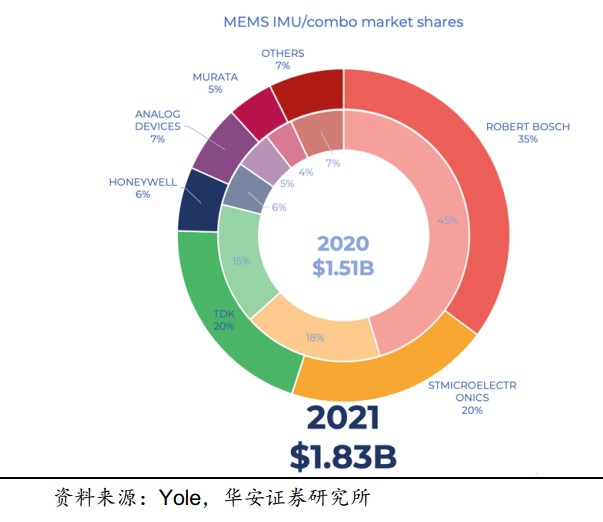According to the market research of Huaan Securities, there are three subdivisions in the field of MEMS sensors that are worth paying attention to, namely radio frequency, inertia and pressure. In the previous part, what are the areas of concern for MEMS sensors (3), we introduced RF MEMS sensors with one of the development potentials, and this article will introduce inertial and pressure MEMS sensors respectively.
Inertial MEMS: Miniaturization creates a new market in the field of inertial navigation
An inertial MEMS system is a micro-system that integrates microsensors, micro-actuators, micro-mechanical structures, micro-power micro-energy, signal processing and control circuits, high-performance electronic integrated devices, interfaces and communications. MEMS systems are as small as a few millimeters in size, and their internal structures are generally in the micron or even nanometer range, which can be mass-produced and have the advantage of low cost.
In the field of inertial sensors, three main technologies are elevating military and civilian capabilities: ring laser gyroscopes (RLGs), fiber optic gyroscopes (FOGs), and MEMS gyroscopes and accelerometers.
From the perspective of MEMS IMU inertial combination and MEMS accelerometer in the main market in the field of MEMS inertia, overseas manufacturers occupy an absolute market share. Among them, the MEMS accelerometer market accounted for $1.22 billion in 2021, Bosch had a market share of 32%, STMicroelectronics had a market share of 21%, Murata had a market share of 13%, NXP had a market share of 11%, and ADI had a market share of 7%.

Figure: MEMS Accelerometers Market Share and Space
In the MEMS IMU inertial combination market, the market size was $1.83 billion in 2021. Bosch accounted for 35%, STMicroelectronics accounted for 20%, TDK accounted for 20%, Honeywell accounted for 6%, and ADI accounted for 7%.
At present, China has mastered the main technical links such as MEMS inertial sensor design, manufacturing, packaging and testing, and has the ability to develop high-performance MEMS sensor products. Under the background of domestic substitution, system manufacturers have a huge demand for MEMS gyroscopes and MEMS accelerometer products, and domestic enterprises have ushered in new development opportunities.
In recent years, with the rapid development of robotics, artificial intelligence, materials science and other fields, the design and manufacture of humanoid robots have made significant progress. A number of scientific research institutions and enterprises have invested in research and development, and launched a variety of powerful humanoid robots. According to McKinsey's forecast, the global humanoid robot market space can reach 120 trillion yuan, which is a new and huge blue ocean market. According to iResearch's forecast, the average annual compound growth rate of the domestic intelligent robot market will reach 40% in 2021~2025, and the domestic intelligent robot market will be close to 100 billion in 2025, which will drive the growing demand for MEMS inertial sensors.
Pressure MEMS: Applications in the automotive industry, medical and aerospace
As an important part of the MEMS industry, pressure MEMS sensors have developed rapidly in recent years. According to the analysis in 2021, MEMS pressure sensors are mainly divided into three types: capacitive, piezoresistive and resonant, which are widely used in automotive, medical, consumer electronics and other fields. In the automotive industry, MEMS pressure sensors are used for manifold pressure measurement, barometric pressure measurement, cylinder air pressure measurement, fuel injection pressure measurement, inflation pressure measurement, and tire pressure monitoring.
The global MEMS pressure sensor market is relatively concentrated, with major manufacturers including Bosch, Denso, Sensata, GESensing, and Freescale. With their rich technology accumulation and huge production capacity, these companies occupy a dominant position in the global market.
Although China's MEMS pressure sensor industry started late, it has developed rapidly in recent years. The main domestic production and research enterprises include Suzhou Minxin Microelectronics, Beijing Jade Bird Yuanxin, Wuxi Navitas Electronics, etc.

Figure: Market Share of Key Players in Pressure MEMS
With the support of national policies, China's MEMS industry has continuously improved its R&D and production system, providing a good development environment for the industry. In 2020, the market size of MEMS pressure sensors in China was about 13.5 billion yuan, and it is expected that the market size will be close to 30 billion yuan by 2025, especially driven by the UAV market, the demand for MEMS pressure sensors will grow significantly.
The future application trend of MEMS pressure sensors is mainly to evolve towards miniaturization, multi-functionalization, and networking. With the development of Internet of Things technology, MEMS pressure sensors are gradually developing in the direction of intelligence and networking. By combining with AI, DSP and other technologies, MEMS pressure sensors can achieve smarter and more adaptive monitoring and control functions.
Click here for more info:
Which Field of MEMS Sensor Should We Focus(1)
Which Field of MEMS Sensor Should We Focus(2)
Which Field of MEMS Sensor Should We Focus(3)
Which Field of MEMS Sensor Should We Focus(5)
Which Field of MEMS Sensor Should We Focus(6)






